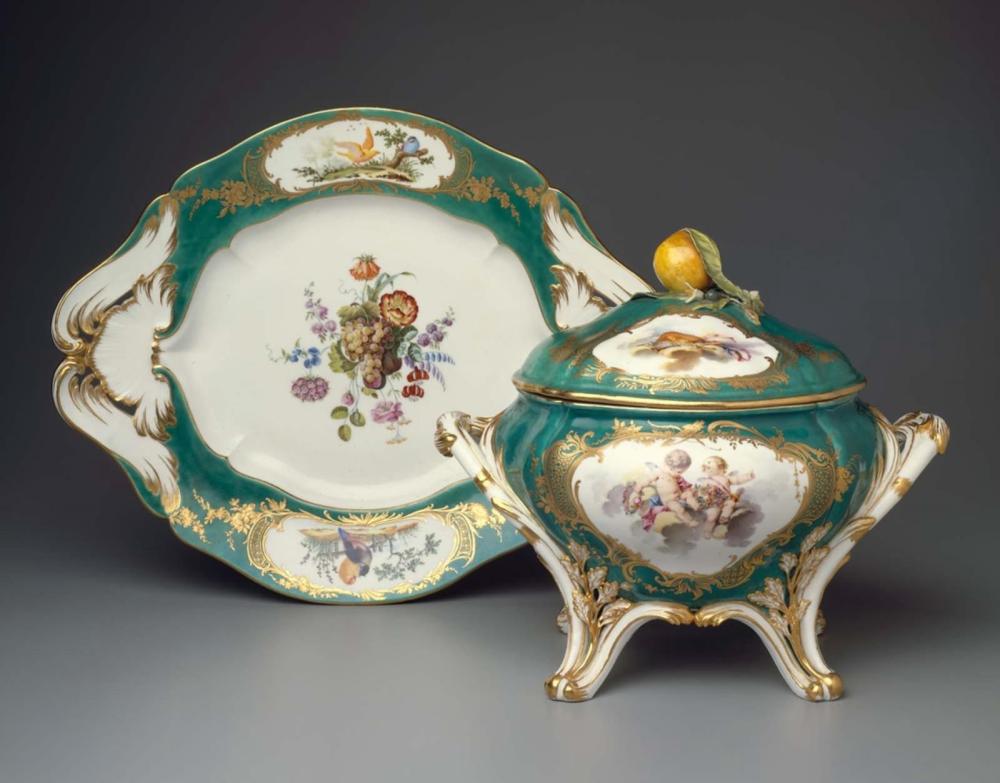Advanced Search 
pot a oille du roi et plateau

Covered Tureen with Stand
pot a oille du roi et plateau
Made at: Vincennes/Sèvres Manufactory (France)
Possibly decorated by: Charles-Nicolas Dodin (French, 1734–1803)
Possibly decorated by: Charles-Nicolas Dodin (French, 1734–1803)
French
1756
Medium/Technique
Soft-paste porcelain decorated in polychrome enamels and gold
Dimensions
Overall (tureen with lid): 28.8 x 33.8 x 27 cm (11 5/16 x 13 5/16 x 10 5/8 in.)
Other (stand): 6.1 x 45.3 x 36.7 cm (2 3/8 x 17 13/16 x 14 7/16 in.)
Other (stand): 6.1 x 45.3 x 36.7 cm (2 3/8 x 17 13/16 x 14 7/16 in.)
Credit Line
Bequest of Forsyth Wickes—The Forsyth Wickes Collection
Accession Number65.1885a-c
NOT ON VIEW
CollectionsEurope
DescriptionThe round tureen is divided into four equal sections by slight indentations which begin at the feet, extend the height of the body, and
are continued onto the domed lid. Branches spring from the scrolled feet to form handles where they join on the sides, and molded branches of oak leaves rise from the feet and extend to the sides of the reserves of the front and back. An orange with its stem, leaves, flowers, and buds forms the finial of the cover. The ground color is a slightly mottled green with a bluish cast. The reserves of the cover are painted with trophies of love and music and are enframed by particularly elaborate gilt borders of flowers, scrolls, and diapered panels. The reserves of the body are painted with cherubs holding floral wreaths, a torch, and a quiver of arrows resting on clouds; they are enclosed by even more elaborate gilt borders that include flowers, garlands, diapered panels, scrolls, and a lyre and a
trumpet on one side, a bow and quiver of arrows on the other. Sprays of gilt flowers are found under the handles, and gilding has been
used to pick out the details of the branch handles and the branches of oak leaves.
are continued onto the domed lid. Branches spring from the scrolled feet to form handles where they join on the sides, and molded branches of oak leaves rise from the feet and extend to the sides of the reserves of the front and back. An orange with its stem, leaves, flowers, and buds forms the finial of the cover. The ground color is a slightly mottled green with a bluish cast. The reserves of the cover are painted with trophies of love and music and are enframed by particularly elaborate gilt borders of flowers, scrolls, and diapered panels. The reserves of the body are painted with cherubs holding floral wreaths, a torch, and a quiver of arrows resting on clouds; they are enclosed by even more elaborate gilt borders that include flowers, garlands, diapered panels, scrolls, and a lyre and a
trumpet on one side, a bow and quiver of arrows on the other. Sprays of gilt flowers are found under the handles, and gilding has been
used to pick out the details of the branch handles and the branches of oak leaves.
Marks
Stand: interlaced Ls in blue enamel (mostly obliterated); incised g. Tureen: interlaced Ls and the letter D approximately 1 1/2" to the right in blue enamel; incised g.
Provenance1757, probably sold by Sèvres factory to Lazare Duvaux (b. 1703? - d. 1758), Paris; 1758, probably sold by Duvaux to Louis XV and presented as a gift to King Frederick V of Denmark (b. 1723 - d. 1766) [see note 1]. Until 1910, Imperial Winter Palace, Saint Petersburg (inventory numbers r.4/707, r.4/707a, and r.4/708 in red enamel paint); 1910, transferred from the Winter Palace to the State Hermitage Museum, Saint Petersburg; 1933, deaccessioned by the Hermitage [see note 2]. 1948, I. Rosenbaum N. V., Amsterdam [see note 3]; January 6, 1948 sold by Rosenbaum to Rosenberg and Stiebel, New York; January 6, 1948, sold by Rosenberg and Stiebel to Forsyth Wickes (b. 1876 - d. 1964), New York and Newport, RI; 1965, bequest of Forsyth Wickes to the MFA. (Accession Date: December 24, 1965)
NOTES:
[1] Jeffrey H. Munger, "The Forsyth Wickes Collection in the Museum of Fine Arts, Boston" (Boston, 1992), p. 167. [2] According to correspondence from Jan Vilensky of the State Hermitage Museum (June 9, 2004). The tureen and stand were once part of a service that was inventoried at the Winter Palace and transferred to the Hermitage, where a part of the service remains. [3] Jacob Rosenbaum founded the family art business in Frankfurt in the 19th century; his son Isaak opened a gallery in Amsterdam, and his nephew established Rosenberg and Stiebel in New York in 1939.
NOTES:
[1] Jeffrey H. Munger, "The Forsyth Wickes Collection in the Museum of Fine Arts, Boston" (Boston, 1992), p. 167. [2] According to correspondence from Jan Vilensky of the State Hermitage Museum (June 9, 2004). The tureen and stand were once part of a service that was inventoried at the Winter Palace and transferred to the Hermitage, where a part of the service remains. [3] Jacob Rosenbaum founded the family art business in Frankfurt in the 19th century; his son Isaak opened a gallery in Amsterdam, and his nephew established Rosenberg and Stiebel in New York in 1939.
